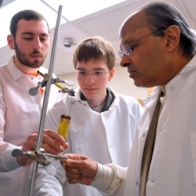Nanotechnology collaboration aimed at curing cancers with “smart implants”
Nanotechnology collaboration aimed at curing cancers with “smart implants”
Date: 12/21/2009
Researchers at Northeastern’s Electronic Materials Research Institute (eMRI) are collaborating with two Harvard Medical School researchers to develop a nanotechnology-based “smart implant” to treat cancer.
The device could improve the efficiency of radiation and drug-based treatments for lung, pancreatic and prostate cancers.
Professor and physics department chair Srinivas Sridhar, director of the eMRI, is leading a team of Northeastern research scientists and graduate and undergraduate students in the effort to develop the smart implants. They are partnering with Michael Makrigioros, of Brigham & Women’s Hospital and Robert Cormack of Dana-Farber Cancer Institute. Both organizations are Harvard Medical School affiliates.
Northeastern co-op students will also have the opportunity to work in the medical physics and biophysics group at Harvard Medical School.
“This collaboration allows us to bring our nanotechnology-based cancer treatment applications to the next level,” said Sridhar. “It is through this type of translational research that real advances in medicine are made.”
A significant number of current cancer treatment protocols include radiation therapy. Radiation therapy requires that markers be inserted into the body to mark the location of the tumor so that the radiation can be accurately targeted.
eMRI researchers have developed a nanoscale, porous coating containing anti-cancer drugs, designed to envelop the tumor marker. Once the “smart” marker is implanted, it would release the drugs into the tumor in a regulated dosage over a period of time.
In addition, the cancer drugs and other biological molecules included in the nanoporous coating would act as radio sensitizers to improve the targeting of radiation treatments.
“We are seeking to utilize the technology developed at Northeastern to create smarter nanotechnology-based devices to treat cancer in a more targeted and timely manner,” said Makrigiorgos. “This technique, which will not be any more inconvenient for patients, could help increase the success rates of these and other cancer treatments in the future.”
Makrigiorgos and Cormack are chief and deputy chief, respectively, of medical physics and biophysics in the department of radiation oncology at Harvard Medical School.
The Northeastern team includes research scientists Dattatri Nagesha and Dayane Tada, graduate students Evin Gultepe and Frank Reynoso, and undergraduate students Evan Jost and Craig Levy, all from the physics department.
For more information about research being conducted at eMRI, please visit http://www.emri.neu.edu/. Additional information about physics research at Northeastern can be found athttp://sagar.physics.neu.edu and http://www.igert.neu.edu.
http://www.northeastern.edu/news/stories/2009/12/SridhareMRIcollaboration.html

